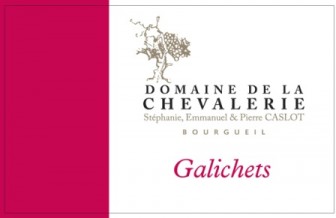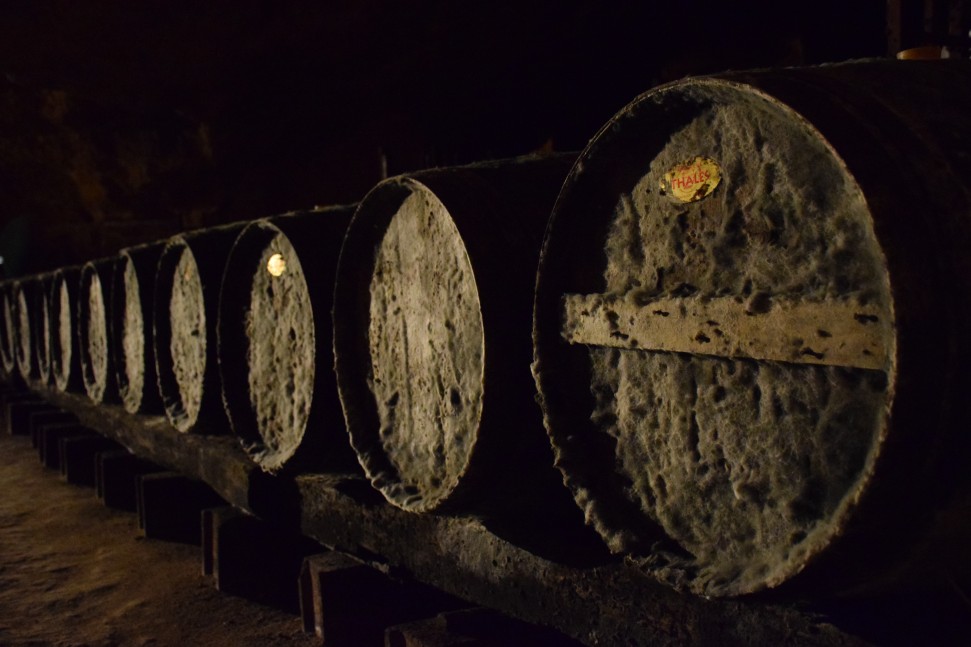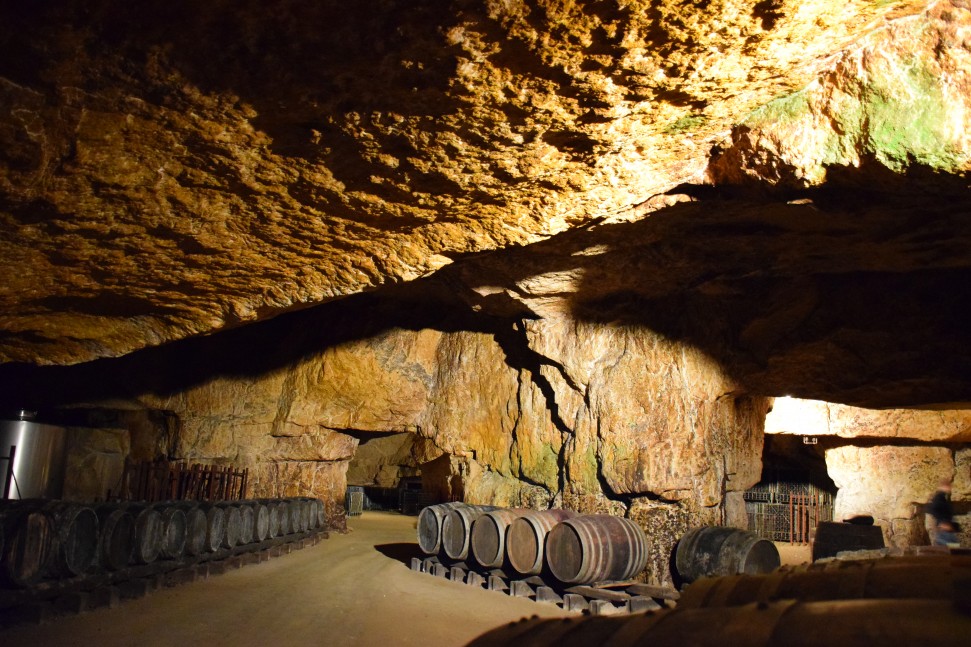Domaine de la Chevalerie, Bourgueil

| Country & Region | France, Loire Valley |
| Appellation(s) | Bourgueil |
| Producer | the Caslot family |
| Founded | 1640 |
| Website | www.domainedelachevalerie.fr |
This little-known domaine makes some of the best Cabernet Franc wines in the world.
–Rajat Parr & Jordan Mackay, The Sommelier’s Atlas of Taste (2018)
Since 1640 this domaine has been in the Caslot family. Their house, office, and winery sit upon one of Touraine’s largest cellars — a great cavernous affair dug out between the 11th and 13th centuries to provide stone for the local village of Restigné. On my first visit to the domaine two decades ago, Pierre Caslot the reigning patriarch led me to a flight of stairs plummeting to the depths. “Entrez,” he laughed: “le Paradis!” It’s down there that he would take clients on tours, walking through vast chambers hewed out by hand. Here and there neat rows of bottles lay on the ground and barrels line the walls. It’s down there too, in one dark corner or another, that Pierre would conduct tastings that might go back fifteen vintages. In 2014, he left this world, and the Loire lost one of its great bon vivants.
In the early 2000s, his son Emmanuel and daughter Stéphanie (pictured below, and taken too soon by illness in 2021) joined Pierre in running the domaine. The primary task he gave them was to take the domaine on an organic footing. He himself had quit using herbicides in the previous decade, but he wanted to go 100% in with organics for all of their vineyards. Thus in 2008 Chevalerie received its first certification, and in 2012 it received Demeter certification for biodynamic farming.

In 2018 these dynamic siblings were joined by their younger sister Laurie (pictured below). Today they farm 81.5 acres of vines, of which 59 grow around the house and cellar and constitute the heart of the domaine. The other acreage is on the high end of the terrace, abutting the ridge that marks the northern boundary of the appellation, and wine from that parcel is sold to négociants. They also rent parcels from two acclaimed limestone sites: Grand Mont to the west, and Bretêche to the east.

The Loire itself marks the southern boundary of Bourgueil and of the adjacent appellation of St-Nicolas-de-Bourgueil. What lies in between the river and ridge is a broad fan of a sloping terrace. This is the appellation ground and it’s composed of varying amounts of sand and gravel deposited by the Loire over the eons to mix with clay, anchored by varying degrees of limestone.
Across the Loire are its other two great red appellations. Southeast is Chinon; southwest is Saumur. Chinon tends to be warmer and drier than Bourgueil, particularly in Chinon’s eastern zone around Cravant, where growers typically harvest a week and a half earlier. Saumur has similar rainfall to Bourgueil but is also warmer and normally harvests earlier. In very general terms, Chinon makes the softest wine, Bourgueil and St-Nicolas-de-Bourgueil the most structured (there’s little discernable difference between these two right bank appellations), and Saumur’s wine tends to have a distinctly darker fruit profile.

Chevalerie’s home vineyards grow on the upper end of the terrace, far inland from the river. Here the soils are relatively heavy with clay and limestone, without much sand, making for mouth-filling Bourgueils. These vineyards are always harvested below 40 hectoliters per hectare (the legal permitted maximum yield is 55 hl/ha). The grapes are harvested by hand into small crates, sorted twice and destemmed but not crushed; the grapes go into vat whole to be fermented with indigenous yeast before aging in vat or in older 400 or 500L barrels for roughly eight months–a relatively short élevage to keep the focus on the intrinsic fruit. They are almost always bottled without fining or filtration. These are deliciously meaty, dense, and astonishingly age-worthy Loire Cabernet Francs.

The Wines
| Wine | Blend | Description |
|---|---|---|
| Cuvée Diptyque | Loire Cabernet Franc | This is the domaine’s vin de soif, made from vines growing in gravelly, sandy, and clay-sandy soils. The élevage is in concrete vats with, sometimes, a small proportion done in older barrels. Light maceration—the intent is to have an easy, supple wine. Diptyque is ancient Greece referring to two panels linked together. In painting, this is two panels linked; in music, an oeuvre in two parts. Here, with wine, it is a cuvée made with sun and soil. In normal years, production averages a little over 1,600 cases. Tech sheet here. |
| Galichets | Loire Cabernet Franc | A 25-acre vineyard heading down the terrace toward the river that is planted on stony, sandy clay soils (the limestone bedrock is at least three feet below the surface and typically more). The oldest vines in Galichets date from 1934. A part of that plantation was replanted in the 1970s and 80s, with yet another small section replanted in the 1990s. The siblings are beginning to replant some of the oldest vines now, bringing the average age of this vineyard to 40 years. Galichets tends to make the domaine's spiciest and fruitiest wine, underpinned by a dark sappiness. Production averages 1,500 cases. Tech sheet here. |
| Chevalerie | Loire Cabernet Franc | A 20-acre parcel between Galichets and the winery, planted on about two feet of clay overlying limestone. This was initially planted in 1893 and this site, like Busardières, supports older vines better than the above two parcels. Average vine age here is 55+ years old, and the wine typically has the intense, full fruit of Galichets but with more tannic structure. These days, the grapes from the sandiest section of this vineyard, nearest Galichets, goes into the Galichets cuvée. Production of La Chevalerie has been down in recent years because of successive frosts: average recently is 250 cases. Tech sheet here |
| Busardières | Loire Cabernet Franc | Another 7.4-acre block just above the winery that grows in a thin layer of topsoil less than 12 inches deep overlying hard clay, which in turn overlies solid limestone. Half of the vineyard was first planted in 1880; half in 1922, and subsequent replantings have been vine by vine, replacing vines as needed. Average age of the vines is now 70 years old. 400 cases in a normal year. This tends to be stonier, leaner and more austere than the above wines, with notable length and finesse coming out in time. Tech sheet here. |
| Bretêche | Loire Cabernet Franc | Bretêche is an old word referring to a window or entrance to a fortified building, often above a gate to enable defenders to rain arrows or what have you upon attackers. It can also refer to entrances and exits in general, and this particular vineyard grows on the edge of the Restigné commune, where a road comes in. Pierre Caslot planted his parcel between 1988 and 1992 after his wife inherited the rights to rent it from her family. They farm just over 13 acres here. The soils are young limestone and a little clay, and this makes for a long, more linear wine than Galichets or Chevalerie, one with evident stony aromatics, lift and focus given by the limestone. Production averages 1,250 cases. Tech sheet here. |